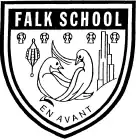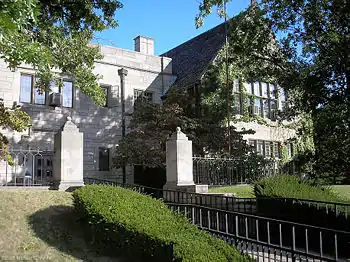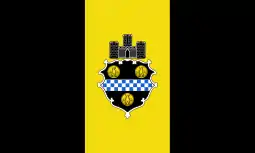Fanny Edel Falk Laboratory School
The Fanny Edel Falk Laboratory School, or simply the Falk School, is a private kindergarten through eighth grade laboratory school of the University of Pittsburgh. It is located on the University of Pittsburgh's upper campus on Allequippa St.
| Fanny Edel Falk Laboratory School | |
|---|---|
 | |
| Location | |
United States | |
| Information | |
| Type | Private |
| Established | 1931 |
| Principal | Jill Sarada, Ph. D. |
| Grades | K–8 |
| Enrollment | 429 |
| Website | Falk School |
Charter
Falk Laboratory School was established in 1930 under a charter agreement between the University of Pittsburgh and benefactors Leon Falk Jr. and his sister, Marjorie Falk Levy. The school was named in honor of Leon and Marjorie's mother, Fanny Edel Falk.[1] It features progressive, experiential, and inquiry-based instruction and develops and refines its own curriculum.[2]
Originally chartered as a progressive experimental school for demonstration purposes, Falk School's charter was amended in 1946 to include the mentoring and observation of practice teachers as one of the school's functions. It is the only known laboratory school in existence to have a legal charter that stipulates its purposes and functions. Over the years the faculty added to the school's original functions to incorporate educational research and to integrate new educational practices as they are developed. Teachers are in charge of, and responsible for, developing their own curricula and programs.[3]
History
Progressive laboratory child education at the University of Pittsburgh was established when a laboratory school for children four to seven years old was opened by the School of Education on October 6, 1913.[4] The original school grew into two schools, collectively known as the University Demonstration Schools, composed of the School of Childhood, for children up to second grade, and the Elementary School for grades three, four, and five.[5] Following a reorganization within the School of Education, the University Demonstration Schools became independent and continued as a private project known as the Community School until the establishment of the Falk School in 1931,[5] at which time it reabsorbed the Community School.[6]
The Falk School opened on September 14, 1931[7] with 78 enrolled children, a principal, seven full-time teachers, and a part-time teacher from the Department of Physical Education.[8] The school at first was placed in temporary quarters in the Stephens house of the university until its own dedicated facility opened a few weeks later.[7] Martin P. Chworowsky served as its original director. The Falk School facility had an original capacity for 155 children and included a nursery, kindergarten, and classrooms for first through sixth grades. It originally admitted children from two and one-half to twelve years of age.[8] A health program was directed by the Women's Medical Adviser of the University of Pittsburgh. The three lower grades had sessions between 9am and noon, while the upper grades met from 9am to 3:15pm.[8]
By the end of Falk School's sixth year, it expanded to eight grades with full training for high school.[9] Ongoing expansion and renovations allowed for a planned increase in enrollment from 275 students in 2008 to 429 in 2018.
Tuition for Falk School was originally $200 a year for lower grades and $275 a year for upper grades.[8] Current tuition for 2018-2019 is $15,370 per year, for all grade levels K-8.[10]
Building

A Tudor-style gray stone school house with Old English slate shingle roof, the Falk School building was designed by Janssen and Cocken and built in 1931 at an original cost of $200,000.[7] The cornerstone of Falk School was laid in August, 1931 and contains, among other papers, a speech read by Majorie Falk Levy in which she described the life and charter of her mother, and the school's namesake, Fanny Edel Falk.[8] The building was designed to initially accommodate 155 students in its eight classrooms.[8]
Expansion of the Falk School, from the 28,000-square-foot (2,600 m2) facility to a 65,000-square-foot (6,000 m2) facility occurred in 2008 and renovations of the original building were completed in 2009. The $21.1 million expansion and renovations, designed by architectural firm Perkins Eastman,[11] features several green building components and will allow for increased enrollment of up to 403 students by 2012. The new 38,000-square-foot (3,500 m2) academic wing for the school includes 14 classrooms for Kindergarten through eighth grade, a new computer classroom (now has been transformed into the WonderLab, A Hub For Learning Through Making[12]), art room, library, cafeteria, science room, and support areas. The outdoor play area was relocated to the west side of the building and a new play area was constructed on the gym roof. The front facade of the new addition is designed to match the stone finish of the old building with a circular drive to enhance student safety during drop-off and pick-up. The back of the building has a more modern look with red siding and two walls of windows that enclose the expanded cafeteria and library space. The back also has two outdoor terraces and a sidewalk for easy access to the renovated ground-level play spaces.
Administration
The Head of School (Director) of Falk Laboratory School is a member of the Executive Committee in the University of Pittsburgh's School of Education and the Chair of the Falk School Board is the School of Education's Dean. Falk School teachers are faculty in the University of Pittsburgh's School of Education and the Director holds the rank of Associate Professor at the University. Falk is a teacher-training site for education students at the University of Pittsburgh with as many as 30 Master of Arts in Teaching candidates apprenticing at Falk each year.
Notable alumni
Several graduates of Falk School have gone on to distinguish themselves or have been children of famous parents.[11]
- Monte Buchsbaum — world-renowned neuropsychiatrist and son of author and invertebrate biologist Ralph Buchsbaum
- Vicki Buchsbaum Pearse - marine biologist/author/editor and daughter of Ralph Buchsbaum
- David Greene — American journalist and one of the co-hosts of Morning Edition on National Public Radio
- Patti Deutsch — comedic television actress and voice-over artist best known for her work on Rowan & Martin's Laugh-In and as a mainstay on the celebrity panel of the 1970s game show Match Game
- Alec Karakatsanis - American civil rights lawyer, social justice advocate, recent recipient of the Stephen B. Bright Award by Gideon's Promise and the Trial Lawyer of the Year Award by Public Justice, co-founder of Equal Justice Under Law, and founder and Executive Director of Civil Rights Corps, a Washington D.C. impact litigation nonprofit
- Lorin Maazel — world-renowned conductor, violinist and composer[13]
- Rob Marshall — Broadway choreographer and director of such movies as Into the Woods, Chicago, Memoirs of a Geisha, and Mary Poppins Returns
- Ivan Abrams - American lawyer known for his rule-of-law work in southeastern Europe and Central Asia, as well as for work as a prosecutor and defense lawyer in the United States
- Kathleen Marshall — Tony Award winning choreographer and Broadway director. Broadway credits include: Damn Yankees (director, 2017); In Transit (director and choreographer, 2016); Anything Goes (choreographer, 2011); The Pajama Game (director and choreographer, 2006), among others
- John Rogers — son of Fred Rogers
- Jonathan Salk and Peter Salk — children of Jonas Salk
- Wilver "Willie" Stargell Jr. and Kelli Stargell - children of Pittsburgh Pirates legend Willie Stargell
- Fritz Weaver — Tony Award winning stage, screen and television actor[13]
- Owen Young — cellist, Boston Symphony Orchestra
References
- "Falk Laboratory School: History". University of Pittsburgh. Archived from the original on 2011-07-26. Retrieved 2010-10-10.
- "Overview of Falk School". University of Pittsburgh. Archived from the original on 2010-10-13. Retrieved 2010-10-10.
- "About Falk History". University of Pittsburgh. Retrieved 2019-06-21.
- Starrett, Agnes Lynch (1937). Through one hundred and fifty years: the University of Pittsburgh. Pittsburgh, PA: University of Pittsburgh Press. pp. 428–429. Retrieved 2010-08-26.
- Starrett, Agnes Lynch (1937). Through one hundred and fifty years: the University of Pittsburgh. Pittsburgh, PA: University of Pittsburgh Press. p. 429. Retrieved 2010-08-26.
- Starrett, Agnes Lynch (1937). Through one hundred and fifty years: the University of Pittsburgh. Pittsburgh, PA: University of Pittsburgh Press. p. 441. Retrieved 2010-08-26.
- "Plan for Falk School Opening". Pittsburgh Post-Gazette. 1931-08-31. Retrieved 2010-08-26.
- "Report of the Chancellor to the Trustees 1930-1932". University of Pittsburgh Bulletin. Pittsburgh, PA: University of Pittsburgh. 29 (1): 63–64. 1932-10-15. Retrieved 2010-08-27.
- Starrett, Agnes Lynch (1937). Through one hundred and fifty years: the University of Pittsburgh. Pittsburgh, PA: University of Pittsburgh Press. p. 442. Retrieved 2010-08-26.
- "Falk School: Tuition & Fees". Pittsburgh, PA: University of Pittsburgh. 2010. Archived from the original on 2011-07-26. Retrieved 2010-10-10.
- Blake, Sharon S. (2009-09-14). "Falk Elementary School Goes Green and Expands". Pitt Chronicle. University of Pittsburgh. Archived from the original on 2016-03-03. Retrieved 2013-02-11.
- "WonderLab: A Hub For Learning Through Making". Falk Laboratory School. 2016-06-09. Retrieved 2018-11-22.
- "Feature | Pitt Magazine | University of Pittsburgh". Archived from the original on 2015-09-06. Retrieved 2014-05-21.
